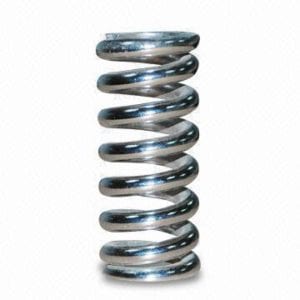 Passivated springs are a necessary finishing step in the manufacturing of spring components, especially important in custom springs for medical devices or those for use in the food industry. Springs can be made with a variety of materials from a number of polymers to a wide range of metals. However, most springs used in industrial applications are formed with varying grades of spring-tempered stainless steel wire. After they are formed, springs need to be cleaned and then passivated with an acid solution. What is the purpose of passivated springs and the passivation process? The following pocket guide offers some detail on answering those questions and touches on the importance of passivation in the post-fabrication of stainless steel springs.
Passivated springs are a necessary finishing step in the manufacturing of spring components, especially important in custom springs for medical devices or those for use in the food industry. Springs can be made with a variety of materials from a number of polymers to a wide range of metals. However, most springs used in industrial applications are formed with varying grades of spring-tempered stainless steel wire. After they are formed, springs need to be cleaned and then passivated with an acid solution. What is the purpose of passivated springs and the passivation process? The following pocket guide offers some detail on answering those questions and touches on the importance of passivation in the post-fabrication of stainless steel springs.
What is Passivation?
As a post-fabrication method, passivation is intended to maximize the natural corrosion resistance of stainless steel. Stainless steel is a steel alloy that contains a minimum of 10.5% chromium content by mass and a number of other alloys. When stainless steel is newly formed it needs to be cleaned of lubricants, oils, greases and other substances used in its fabrication. Once the steel has been cleaned it must be passivated. Passivation is a process that treats metal surfaces with an acid solution to make the surface corrosion resistant.
The term ‘passive’ refers to how steel becomes ‘unreactive’ i.e., passive to atmospheric conditions by removing the free iron from the surface that causes corrosion. Once treated with an acid solution, slowly and naturally a passive layer develops on the surface of the steel as the chromium at the surface reacts with oxygen in the air to produce chromium oxide. The molecular layer of chromium oxide provides a barrier to prevent oxygen and moisture from reaching the iron underneath that would otherwise rust if oxygen and moisture contact the iron.
The Purpose of Passivated Springs
Because springs are highly susceptible to corrosion they need to be passivated. If springs are not passivated after they are formed, pitting and cavity corrosion of the metal will occur, reducing its strength, thickness, and structural integrity. In addition to environmental conditions, corrosion can occur simply through contact. Without passivation, if oxide deposits from a rusting piece of metal touch non-rusting stainless steel it will spread beyond the point of contact. Corrosion can also happen in any crevice or confined space on a metal’s surface, such as the gaps between a nut and a bolt.
How Passivated Springs are Treated
Passivated springs are treated through citric acid passivation or nitric acid passivation. Either method treats the metal with an acid solution that acts to remove any free iron from the metal’s surface before that iron can react to water and oxygen in the air, causing rust oxidation.
Nitric acid was long used as the only method to passivate stainless steel before studies showed that citric acid in many instances provided a safer, more effective means with many advantages. Citric acid is organic, bio-friendly, and safe to use. It is derived from citrus fruits—oranges, lemons, limes, etc.—and it offers excellent results at considerably lower costs. In the U.S., 99% of the citric acid sold is consumed as a food and beverage product or used in cleaners and disinfectants. Nitric acid has a low cost for the raw material, but high maintenance and disposal costs. The process requires a separate space with a proper ventilation system, and special handling equipment by employees to ensure no inhalation of fumes or that anyone sustains chemical burns from an accident with the acid. As a hazardous waste, nitric acid needs to be properly stored before use and then transferred to a hazardous waste site for treatment and disposal after use.
The use of citric acid passivation or nitric acid passivation of springs depends on its application. Medical-grade stainless steel device passivation is an important aspect of taking care of medical parts and components. Today, custom springs for medical devices generally receive citric acid passivation due to its ease of chemical handling, disposal and overall safety for employees involved in the passivation of springs. On the other hand, food-grade stainless steel springs manufactured for use in the food industry typically utilize nitric acid passivation.
In the manufacturing of springs, passivation is a necessary step that is used to resist corrosion and further removal of contaminants from the surface of stainless steel components that have accrued during the manufacturing process.

